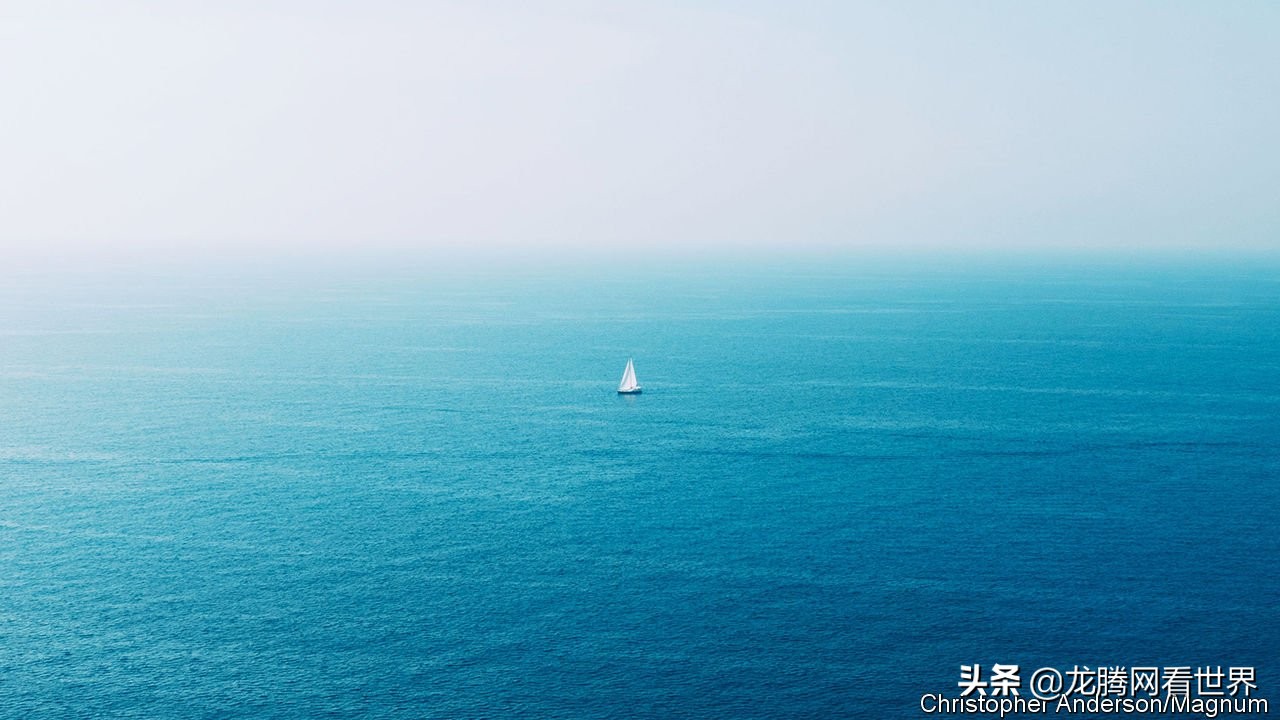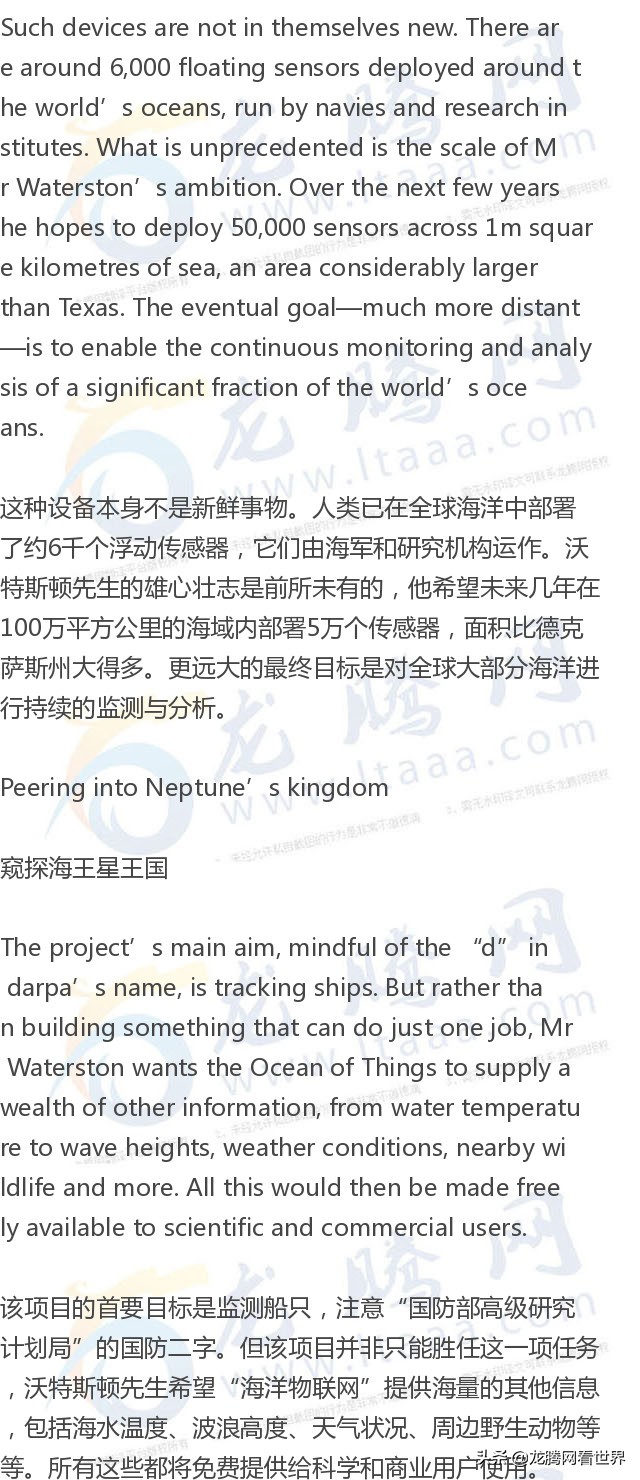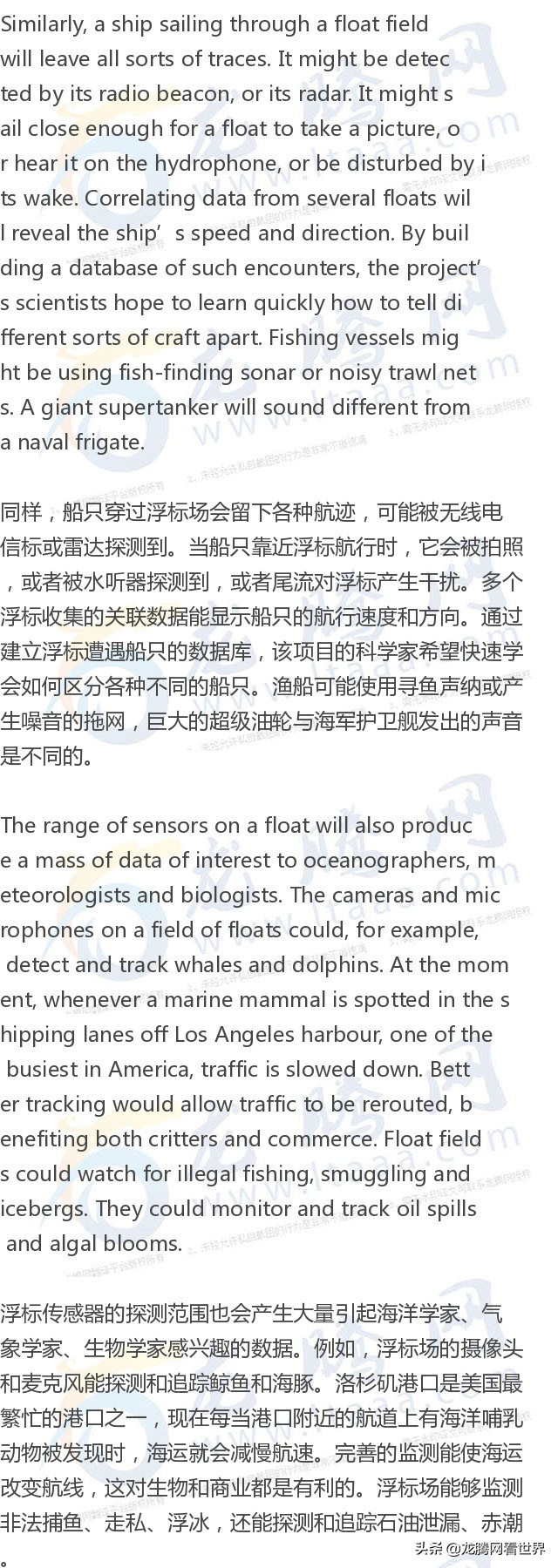经济学人
Monitoring the high seas
监测公海
American researchers want to fill the oceans with sensors
美国科学家想让传感器遍布海洋
They could track ships, storms, wildlife and weather
传感器可监测船只、风暴、野生动物、天气

There is twice as much water on Earth as land. Oceanographers are nevertheless fond of saying that science knows less about the high seas than it does about the moon. If John Waterston gets his way, though, that could soon change.
地球上水的面积是陆地面积的两倍,但海洋学家常说,科学对公海的了解少于对月球的了解。如果约翰·沃特斯顿如愿以偿,那么这一现状可能发生改变。
Mr Waterston is the head of the “Ocean of Things” project at the Defence Advanced Research Projects Agency (darpa), an American military think-tank that has helped develop everything from the internet to stealthy fighter planes. The project’s name is a play on the “Internet of Things”, the awkward phrase which describes the trend for stuffing sensors and an internet connection into all manner of ordinary obxts, from cars and toothbrushes to factory robots and doorbells. The Ocean of Things aims to likewise wire up the high seas with swarms of floating, connected sensors.
沃特斯顿先生是美国国防部高级研究计划局“海洋物联网”项目的负责人,这家美国军事智囊机构为包括互联网、隐形战斗机在内的各种项目的研发提供帮助。该项目的命名衍生于“物联网”,这个别扭的词组是指将传感器和互联网融入包括汽车、牙刷、工业机器人、门铃在内的各种普通物品中。同样,“海洋物联网”旨在将公海与大量互联的浮动传感器连接在一起。

Existing “floating instrument packages”, known as floats or drifters, are often custom-built, and usually contain the highest-quality instruments available. They therefore tend to be expensive, and are bought only in small numbers. A typical existing float, designed for scientific research, is the Argo. It costs around $20,000, and can measure water temperature and salinity.
现有的“浮式仪器组件”也被称作浮标或漂标,通常是定制的,包含现有最高质量的仪器。它们往往造价高昂,只能少量采购。Argo是被设计用于科研的一种典型浮标,造价约2万美元,能够测量海水温度和盐度。
The Ocean of Things takes the opposite approach. The aim is to cram as many cheap, off-the-shelf components as possible into a single low-cost package. Current float prototypes cost around $750, and Mr Waterston hopes that economies of scale could drive the cost down further. That would allow tens of thousands to be deployed without breaking the bank. Large numbers are crucial for coverage. They also help compensate for inaccuracies in individual instruments. “Can a $5 sensor do the same things as a $1,000 temperature gauge?” Mr Waterston asks rhetorically. “The answer is ‘yes’ if you have a lot of them, because you can cross-correlate. Maths solves the problem for you.”
“海洋物联网”采取了相反的办法,旨在将低廉、现成的部件尽可能多地集成到单个低成本组件中。现有的原型浮标造价约750美元,沃特斯顿先生希望规模经济可进一步降低成本,不必斥巨资就能部署上万个浮标。大量部署对于覆盖范围来说至关重要,还能弥补单个仪器测量不准的缺陷。“5美元的传感器能做到1000美元的水温表所做的事情吗”?沃特斯顿先生反问道。“如果部署的数量够多,那么答案是肯定的,因为可以进行互相关运算,数学能为你解决问题”。
The project’s researchers are uating three designs from different manufacturers, ranging in size from about six to 18 litres. One, proposed by Xerox’s Palo Alto Research Centre, is made of glass, like a traditional Japanese fishing float. A second, from a firm called Areté Associates, has an aluminium shell, and uses wood for buoyancy. Both models feature solar panels. The third, made by a company called Numurus, is made of lacquered cardboard, and relies entirely on its batteries. All three are designed to last for a year or so and are made to be as environmentally friendly as possible, with minimal use of plastics. That is important because, at the end of their mission, the floats are designed to scuttle themselves.
该项目的科学家正在评估各家制造商给出的三种设计方案,容量从6升到18升不等。施乐复印旗下的帕洛阿尔托研究中心提出的第一种方案采用玻璃材质,类似于日本的传统鱼漂。阿瑞忒联合公司提出的第二种方案采用铝制外壳,利用木头产生浮力。两种设计都采用太阳能电池板。Numurus公司提出的第三种方案采用涂漆硬纸板材质,完全由电池驱动。三种方案的续航时间均为一年左右,并尽可能地做到环保,使用塑料极少。这一点很重要,因为任务结束后,浮标被设计为自动报废。
Some of the instruments on offer are common to any smartphone—gps sensors, accelerometers to detect motion, a compass, a microphone, temperature sensors and a camera. Others are more directly tailored for the job, such as an underwater microphone, a gizmo to measure the water’s conductivity (and therefore its salinity), and detectors to pick up radar and radio signals, including transmissions from marine anti-collision beacons. Some data from these instruments will be crunched on board, but most will be sent back to land in bursts, for onshore analysis. For now, that connectivity is provided by the Iridium network of geosynchronous satellites. But the modems necessary to talk to those satellites, says Mr Waterston, are the most expensive and power-hungry devices on the floats. He hopes that new, lower-flying satellite networks, currently being built by firms such as Spacex and OneWeb, will provide cheaper alternatives.
现有的某些仪器普遍应用于智能手机——GPS传感器、探测运动的加速度计、指南针、麦克风、温度传感器、摄像头。有些仪器是为该项目直接定制的,例如水下麦克风、测量海水电导率的小装置(从而得知盐度)、接收雷达和无线电信号的探测器,包括防止撞击的航路信标。仪器收集的一部分数据在浮标上运算,但大部分数据被迅速传送回陆地用于岸上分析。目前,由地球同步卫星组成的铱星网络提供数据连接。但沃特斯顿说,用来与卫星通信的调制解调器是浮标携带的最昂贵、耗电量最大的设备。他希望Spscex、OneWeb等公司正在建造的低空卫星网络将在未来提供更低廉的选择。
Having lots of different sensors will help the floats build the best possible picture of what is going on around them. For example, if the microphone picks up a sound at the same time as the accelerometer shows movement, it could mean that a bird has landed on the float. Several birds landing on several floats could show how a flock is moving. Their presence, in turn, might be an indicator of shoals of fish or other biological activity.
大量不同的传感器有助于浮标最好地展现周边情况。例如,麦克风探测到声音的同时,加速度计也探测到运动,可能意味着一只鸟落在浮标上。多只鸟落在多个浮标上可以显示出鸟群的迁移方式,而鸟的出现可能表明附近有鱼群或者其他生物活动。

That, at least, is the long-term goal. So far, darpa has bought around 4,500 floats, and has tested them only in small numbers. The next stage, starting this spring, will see fields of 1,000 at a time deployed in the Gulf of Mexico and in the waters off California. The plan is to deploy one float for every three square kilometres of ocean. The hope is that, as the technology matures, useful data could be gleaned from densities as low as one float per 20 square kilometres. With 361m square kilometres of ocean on the planet, a true Ocean of Things, monitoring everything on and under the water, would require about 18m floats. That will not happen for a while yet. But Mr Waterston’s plans are a start.
至少,这是长远目标。迄今为止,美国国防部高级研究计划局已采购4500个浮标,只进行过小批量测试。今年春季将开始下一阶段测试,在墨西哥湾和加利福尼亚州的周边海域一次性部署由1000个浮标组成的浮标场。计划是每3平方公里海洋部署一个浮标,希望随着技术的成熟,密度下降到每20平方公里部署一个浮标也能收集到有用的数据。地球上的海洋面积达3.61亿平方公里,真正的“海洋物联网”需要部署1800万个浮标,监测水面和水下的万物。这一目标暂时无法实现,但沃特斯顿的计划只是个起点。